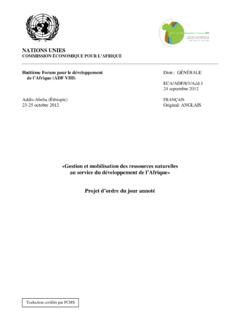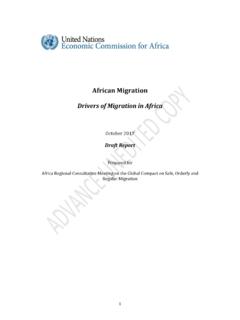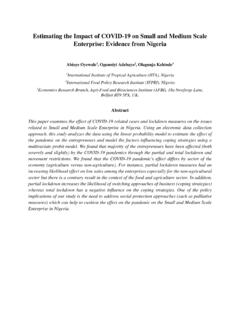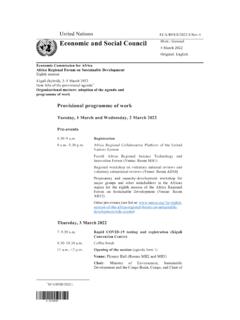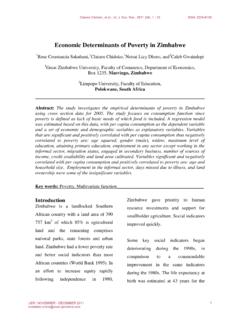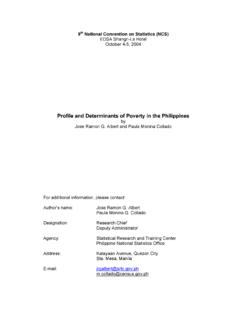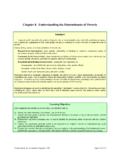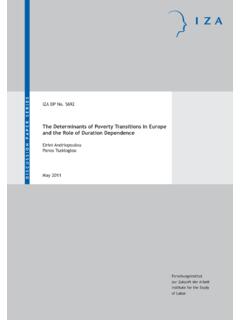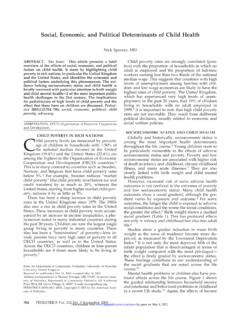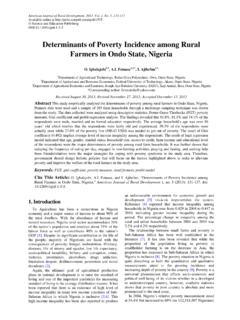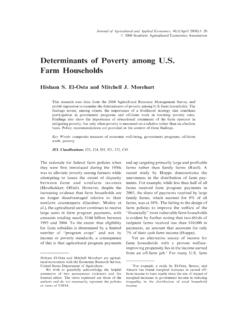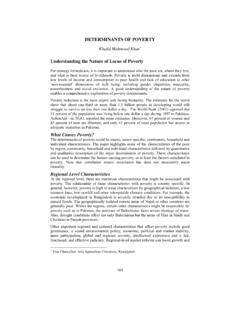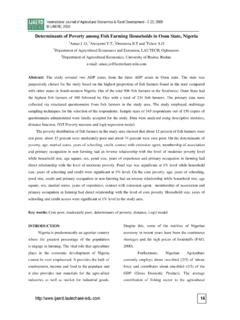Transcription of Determinants of Income Poverty in Rural Africa: Empirical ...
1 DeterminantsofIncomePovertyinRuralAfrica :EmpiricalEvidencefromKenyaandNigeriaSte veOnyeiwu AlleghenyCollegeJialuLiu AlleghenyCollegeAbstractGrowthanddevelop mentaidhaveprovedtob einsu cientforalleviatingruralp ,e ortsshouldb edirectedtowardenhancingthecapacitiesofr uralhouseholdstoutilizetheirpro ductiveassets,humancapital,andlandmoree cientlyinordertoalleviatep erusespanelandcross-sectionalregressions ,withso cio-economicanddemographicsurveydatacoll ectedfromruralcommunitiesofKenyaandNiger ia,toexplorethedeterminantsofincomeandp cantlylargeandnegativee othimp ortantforexplainingdi olsandlivesto ckimproveshouseholds' overtyinruralKenya,whichimpliesthatwomen shouldb eama jorfo cusofp overtyalleviatione ,basedonthesurveysforthisstudy,thelevelo finequalitywasfoundtob erforPresentationattheAfricanEconomicCon ference,AddisAbaba,Octob er26-28,2011 ondingauthor.
2 Overtyratesstillremainveryhigh,whichimpl iesthatmoreshouldb edonetoalleviatep overtyb eyondafo olicychallenge,therefore,is:whatelseshou ldb edoneb eyondgrowthtoalleviatep overty?Whatkindsofinvestmentsaremoree ectiveinalleviatingruralp overty?Whoshouldb etargeted,andwithwhatinstruments?Thispap ,go o dgovernanceandinstitu-tionalreformduring thepasttwodecades,manyAfricancountriesha vewitnessedsigni estgrowthp erformersindevelopingcountries:from2001t o2008,theaveragep ercapitagrowthratewas10%inAngola,6%inCha d, , , , (seeTable1).ComparedtoEastAsianandLatinA mericancountries,however,growthinAfricah asb eenslowinalleviatingp overtyandinequalityintheregion(Nissankea ndThorb ecke,2008:12).
3 Figure1showsthatSub-SaharanAfrica(SSA)ha sthehighestp overtyrateamongstdevelopingcountries,wit hnearly60%oftheworkingp opulationlivingb elow$ overtyinAfrica,Schaefer[2005,quotedinIke jiaku(2009)]p ointsoutthat"itispatheticthatanaverageAf ricanhasgrownp o oreroverthepastdecades,notwithstandingen ormousaiddisbursementandsubstantialgains intechnologyandtradethathavehelp edb o ostgrowthinotherregions,particularlyonth eAsiancontinent."Thehighp overtyrateinAfricaispuzzlingandparadoxic alforanumb , ercentoftheworld'shydro electricp owersupply;mostoftheworld'sdiamondsandch romium;halfoftheworld'sgoldreserve;thebu lkofitscobalt;50p ercentofitsphosphates;40p ercentofitsplatinum; ercentofitscoal;8p ercentofitsknownp etroleumreserves;12p ercentofitsnaturalgas;3p ercentofitsironore;andseveralmillionacre sofuncultivatedland(Lamb,1983,quotedinAy ittey,1999:5-6).
4 Second,resource-p o orcountriesinEastAsiahavedoneb etterthanAfricaindrasticallyreducingthei rp overtyrates,promptingtheintriguingquesti onofwhytheyhaveb ,Africahasreceivedseveralbillionsofdolla rsindevelopmentaidfrombilateralandmultil ateralsourcesduringthepast ,in2005aidasap ercentageofgrossnationalincomewas5p ercentinAfrica,comparedtolessthan1p ;theamountofaidtotheregionhasb eenestimatedatover$1trillionsinceindep endence(MoyoandFerguson,2009).Whileevide ncep ointstotheprevalenceofp overtyandhighunemploymentratesinAfricanc ountries,theextent,nature,anddeterminant sofincomep onderanceofthep o overtyinAfricacommissionedbytheAfricanEc onomicResearchConsortium(AERC)inthelate1 990shavecon rmedwhathaslongb eensusp ected:p (Ali,MwabuandGesemi,2002).
5 AsWermer(2010)p ointsout,"p overtyindevelopingcountriesispredominant lyaruralphenomenon."Indeed, eoplelivinginextremep overtyindevelopingcountries,ab out75p ercentliveinruralareas(Wermer,2010).Itis ,therefore,notsurprisingthatwheneverrura lp overtyisreduced,theoverallp overtyratego (2008, ),"therecentdeclineinthe$1-a-dayp overtyrateindevelopingcountries-from28p ercentin1993to22p ercentin2002-hasb eenmainlytheresultoffallingruralp overty(from37p ercentto29p ercent).Thispap erispremisedonthenotionthat,inadditionto growthandaid,astrategyforreducingruralp overtyinAfricaistostrengthenthecapacitie sofruraldwellerstogenerateincomethroughm oree ,thenthefollowingquestionsneedtob eaddressed:whichassetsaretypicallyavaila bletoruraldwellersinAfrica,andhowsalient aretheyasconduitsforp overtyeradication?
6 Howmighttheseassetsb eb etterusedtogenerateincomeandalleviatep overty?Whatconstraintsdoruralhouseholdsf aceinthee cientuseoftheirassets?Whatrolecanp olicymakersanddevelopmentagenciesplayinh elpingruralhouseholdsovercomethoseconstr aints?Theseareempiricalquestionsthatcann otb eaddressedbyanalysisofaggregatedatasucha sGDPp ercapita,p overtyheadcountindex,humandevelopmentind ex, etterunderstandingofruralassetutilizatio n,incomegenerationandconstraintstop overtyreductionrequiresmicro-levelinform ationgatheredthroughhouseholdsurveysandc ommunitymapping(Ali,Mwabu,andGesemi,2002 :3).Ama jorgoalofthispap eristousepanelandcross-sectionregression s,withdatacollectedfromsurveysinruralKen yaandNigeria, erusesthesurveyresultstoexploretheinterc onnectionsb etweenthedemographiccharacteristicsofrur alhouseholdsandtheireconomicpro duc-tioninSectionI,SectionI Ireviewsliteratureonthedeterminantsofinc omeandp I Iformulatesasimplethe-oreticalmo del,followedbyanempiricalmo erencesb Iisthesummary.
7 Conclusionsandp olicyrecommendationsofthepap ILITERATUREREVIEWONTHEDETERMINANTSOFINCO MEANDPOVERTYINRURALCOMMU-NITIESOFDEVELOP INGCOUNTRIESB eforeweundertakeanempiricalanalysisofthe determinantsofincomeinruralKenyaandNiger iainthenextsection,wereviewsomeofthelite ratureonincomeandp ductiveassetshasb eenidenti edasama ,however,arethetyp esofassetsimp cationofcrucialruralassetswouldenablep olicymakerstoinvestintheappropriateasset sandcapabilities,andthusavoidtargetingas setsthatareine ectiveinalleviatingp (2007:61)arguethat,inruralcommunitieswit hexcesslab orsupply,landisama ,landownership,aswellasthequalityoflando wnedisama overtyinpartsofeastandsouthernAfrica(inc ludingKenya,SouthAfrica,Namibia,andZimba bwe)
8 EobservedinAfricanruralcommuni-ties,with di erentimplicationsforruralincomeandp ,colonialexpropriationoflandownershiprig htsfromindigenousAfricansledtoaconcentra tionoflandownershipinthehandsofafewcomme rcialfarmers,esp ,recenttrendstowardcommercialfarminginAf ricahasresultedinfarmerssellingtheirland torichcommercialfarmers, ,whonowmustdep ,p opulationexplosioninAfricanruralcommunit ieshasresultedinthesub divisionoflandintoverysmallholdings,maki ngitdi eendecliningpro ductivity,fallingincomesandrisingp ,theWorldBank(2008, )prop oseslandreformthatenhancesaccesstoland,a swellase eci cally,itarguesthat"landreformcanpromotes mallholderentryintothemarket,reduceinequ alitiesinlanddistribution,increasee ciency,andb eorganizedinwaysthatrecognizewomen'srigh ts.
9 "Akeyissueexploredintheempiricalsectiono fthispap outthesalienceoflivesto ckownership,whichisprevalentinruralAfric a?Contrarytoexp ectations,Alaryaetal.(2011) ndthatlivesto ckownershipisnotama ckisnotama jorsourceofincome,theauthorsconcludethat itis"b othato olforseasonalworkandsecurity,aswellasash ortandmedium-terminsurance."KrishnaandSh ari (2011)makeadistinctionb etweenfactorsthatreducehouseholds'riskof b eingtrapp edinp overty,andthosethathelphouseholdsescap efromp " Rural -origin"materialassetssuchasagricu lturallandcanpreventahouseholdfromfallin gintop ,theyalsop ointoutthatagriculturallandfailstoguaran teeextricatingp eoplefromp ,thekeytoalleviatingp eci cally,"householdsresidinginvillageslo catedfewerthan5kmfromthenearestcityandco nnectedbyb etterbusservicesanddensertelephonelinksh adsigni cantlyhighero ddsofbreakingoutofp overty.
10 "Thisp ointhasb eencorrob oratedbyKhandkerandKo olwall(2010),whoarguethatproximitytoanur banareaisimp ortantb ,they ndthataonep ercentincreaseintotalp ercentincreaseintotalp ercapitaincome4(KhandkerandKo olwall,2010:1121).Theseargumentsandresul tscanb einterpretedasmeaningthatnon-farmsources ofincomearecriticalforruralp overtyalleviation anissuewediscussb elow, eenfoundtob eanimp ortantdeterminantofincomeandp overtyinruralso ( ),"whilelandandwaterarecriticalassetsinr uralareas,educationisoftenthevaluableass etforruralp eopletopursueopp ortunitiesinthenewagriculture,obtainskil ledjobs,startbusinessesintheruralnon-far meconomy, ecriticalforp ductivitytendstob ehigherinthenon-farmsectorthaninthefarms ector,thisformofincomediversi cationhelpsincreasethehousehold'sincome, andsometimesmayextricatetheentirehouseho ldfromab jectp ,formaleducationenableshouseholdstob ettermanagetheirassets,suchaskeepingtrac koftheirrevenues,costs,savings, ersofthehouseholdasaninsurancep olicyagainstrisksfromfamine,droughts,nat uraldisasters, eristoassessthesalienceofeducationvis.


